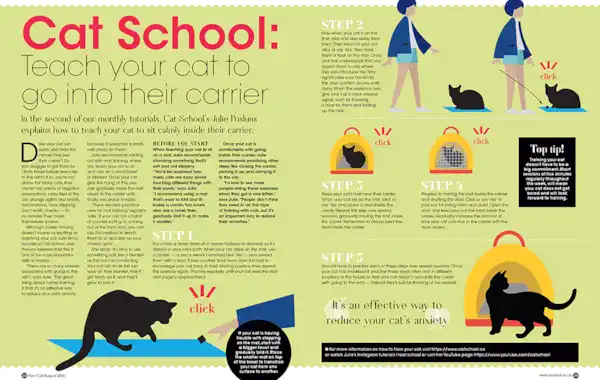Cat School’s Julie Posluns explains how to teach your cat to sit calmly inside their carrier.
Does your cat run away and hide the minute they see their carrier? Do you struggle to get them to climb inside before every trip to the vet’s? If so, you’re not alone. For many cats, their carrier has plenty of negative associations: noisy trips in the car, strange sights and smells, vaccinations, claw clipping, and health checks — it’s no wonder they make themselves scarce.
Although carrier training doesn’t sound as exciting as teaching your cat cute tricks, founder of Cat School Julie Posluns believes that this is one of the most important skills to master.
“There are so many stresses associated with going to the vet’s,” says Julie. “The great thing about carrier training is that it’s an effective way to reduce your cat’s anxiety because it becomes a small, safe place for them.”
Julie recommends starting out with mat training, where you teach your cat to sit and stay on a small towel or blanket. Once your cat gets the hang of this, you can gradually move the mat closer to the carrier until, finally, you place it inside.
“There are also practical uses for mat training,” explains Julie. “If your cat has a habit of counter surfing or running out of the front door, you can use this method to teach them to sit and stay on your chosen spot.”
She adds: “It’s nice to use something soft, like a blanket, as this can be comforting. Your cat will do all this fun work on their blanket, they’ll get treats on it, and they’ll grow to love it.”
Before you start
When teaching your cat to sit on a mat, Julie recommends choosing something that’s soft and not slippery. “You’d be surprised how many cats are fussy about touching different things with their paws,” says Julie. “I recommend using a mat that’s easy to fold and fit inside a carrier. You could also use a towel, then gradually fold it up to make it smaller.”
Once your cat is comfortable with going inside their carrier, Julie recommends practising other steps, like closing the carrier, picking it up, and carrying it to the car.
“I’d love to see more people doing these exercises when they get a new kitten,” says Julie. “People don’t think they need to do this type of training with cats, but it’s an important way to reduce their anxieties.”
Step one
Put a mat or towel down in a narrow hallway or doorway so it’s directly in your cat’s path. When your cat steps on the mat, use a clicker — or say a verbal command like ‘Yes’ — and reward them with a treat. Throw another treat away from the mat to encourage your cat back to their starting position, then repeat the exercise again. Practise regularly until your cat sees the mat and eagerly approaches it.
Top tip
If your cat is having trouble with stepping on the mat, start with a bigger towel and gradually fold it. Place the smaller mat on top of the towel to transition your cat from one surface to another.
Step two
Now when your cat is on the mat, take one step away from them. Then return to your cat, click or say ‘Yes’, then feed them a treat on the mat. Once your cat understands that you expect them to stay where they are, introduce the ‘Stay’ signal: raise your hand into the ‘stop’ position as you walk away. When the session is over, give your cat a clear release signal, such as throwing a treat for them and folding up the mat.
Step three
Place your cat’s mat near their carrier. When your cat sits on the mat, click or say ‘Yes’ and place a treat inside the carrier. Repeat this step over several sessions, gradually moving the mat inside the carrier. Remember to always feed the treat inside the carrier.
Top tip
Training your cat doesn’t have to be a big commitment. Short sessions of five minutes regularly throughout the week, will mean your cat does not get bored and will look forward to training.
Step four
Progress to having the mat inside the carrier and shutting the door. Click or say ‘Yes’ to your cat for being calm and quiet. Open the door and feed your cat the treat inside the carrier. Gradually increase the amount of time your cat can stay in the carrier with the door closed.
Step five
You will have to practise each of these steps over several sessions. Once your cat has mastered it, practise these steps often and in different locations in the house so that your cat doesn’t associate the carrier with going to the vet’s — instead they’ll just be thinking of the reward!
For more information on how to train your cat, visit www.catschool.co or watch Julie’s Instagram tutorials @cat.school or visit her YouTube page www.youtube.com/catschool
See how you can teach your cat to high five here.








